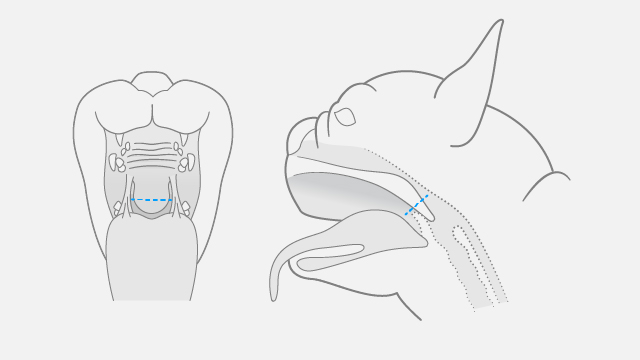
278 Brunker Rd
Adamstown NSW 2289 AU
02 4957 2269
info@brunkerroadvets.com.au

Brachycephalic Obstructive Airway Syndrome
A respiratory problem of short-nosed dog breeds
Overview
What is BOAS?
Brachy means short and cephalic means head. Dog breeds that have been selectively bred for short muzzles are referred to as brachycephalic breeds. The desire for a flat face and domed, foreshortened skull has led to a number of anatomical abnormalities that compromise their ability to breathe. These abnormalities cause obstruction to airflow, and is called brachycephalic obstructive airway syndrome.
Which breeds are affected?
English and French Bulldogs, Pugs, Boston Terriers, Boxers, Pekinese, Shih-tzus along with some rarer breeds such as Japanese Chin and Brussels Griffons, but any dog with a foreshortened face may be affected.
What causes the problem?
Primary anatomic abnormalities when compared to their long nose cousins include thickening and narrowing of the nostrils, excessive bony and soft tissue in the compressed nose with less room for air, an overlong and thickened soft palate and often a relatively large tongue. These primary changes create resistance to airflow that causes the dog to make a much greater effort to pull air into the lungs. The combination of negative pressure and turbulence causes swelling of tissues in the nose and throat, eversion of the laryngeal saccules (a pocket in front of the vocal chords) and ultimately collapse of the larynx.
The brachycephalic obstructive airway syndrome includes the following anatomical abnormalities:
- Narrow or pinched nostrils
- Elongated soft palate
- Everted laryngeal saccules
- Narrow windpipe
- Laryngeal collapse


Elongated soft palate
Signs
The most obvious sign is noisy breathing which is often wet and spluttery. It worsens with exertion, heat and often sleep. Many dogs will spend a lot of time mouth breathing. They generally have poor exercise and heat tolerance, gag and cough when eating and even show vomiting or regurgitation.
The signs of brachycephalic airway syndrome relate to respiratory distress.
| Mild |
Snoring Noisy breathing especially on inspiration Gagging or retching while swallowing |
| Moderate |
Excessive, noisy panting Exercise intolerance |
| Severe |
Blue-tinged tongue or gums Fainting Hyperthermia |
Prolonged respiratory distress such as excessive panting can lead to swelling of the throat and respiratory failure. Many brachycephalic dogs do not realize their limitations and will continue to push their physical activity until a respiratory crisis. Certain triggers can quickly turn mild to moderate respiratory problems into an emergency situation.
These triggers include:
- Increased heat
- Increased humidity
- Excitement
- Stress
- Obesity
Management
The management of brachycephalic airway syndrome can be non-surgical and surgical. Weight management and lifestyle changes are extremely important in the non-surgical treatment plan.
Lifestyle changes include:
| Manage body temperature |
Never let them overheat Never keep in a car Keep them inside on hot days |
| Maintain a healthy body weight |
Keep body weight healthy but more towards the lean side |
| Manage exercise |
Avoid strenuous exercise Do not exercise on hot days |
| Training |
Avoid overexcitement Avoid leash pulling Avoid persistent barking Train them to sit quietly when guests arrive |
Surgery
Surgery may be recommended to stop or delay secondary changes that could worsen the condition. Younger pets that undergo surgery tend to have a good prognosis with marked improvement in activity. However, older pets may have a poorer prognosis depending on the severity of the disease and existing pathological changes.
How is it treated?
It is important to fix problems when the dog is quite young, before severe, irreversible secondary changes occur. Ideally this is done at 7-12 months of age. Occasionally puppies are so severely affected that partial repair must occur sooner than this. Some parts of the problem such as the shape of the bones inside the nose are not repairable. The main surgical goals are to widen the nostrils, shorten the soft palate and remove any laryngeal saccules. Medical therapy to reduce inflammation of the throat and suppress vomiting may have a temporary role, but surgery is always the best long-term solution.
What is the likely outcome?
The key to success is early treatment. In most dogs respiratory noise and difficulty breathing is relieved immediately. Swelling in the period after surgery can occur but is usually well controlled with medication. Older dogs with significant secondary changes may not be reversible and are often left with significant respiratory difficulties, though may still be improved with surgery. Voice changes are occasionally noted.
What post-operative care does my dog need?
Any sutures in the throat are dissolving and do not need removal. The throat heals quickly, but it is advisable to keep the patient cool, calm and avoid exercise for 2 weeks after surgery. The throat will be a little sore so soft foods are advised for 7 days.
Medications
Antibiotics, pain relief and other medications may be dispensed. Please follow the corresponding labels accordingly
What to expect following the procedure?
Some swelling of the throat is expected after your pet has had surgery. Swelling has the potential to cause airflow obstruction, increased breathing noises, and difficulty breathing.
When to call the vet
The below described symptoms can quickly turn into an emergency situation. Please contact us urgently, on 49572269, or call Newcastle Animal Emergency Centre on 1300838669:
- Increased noisy breathing
- Fighting to breathe
- Difficulty swallowing
- Excessive snoring but cannot sleep
- Cyanosis - gums or tongue that turn blue
- Fainting
warm, and helpful.
my questions were answered completely.
and colleagues.